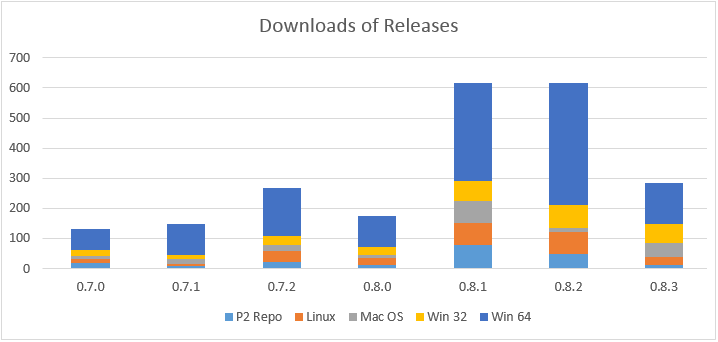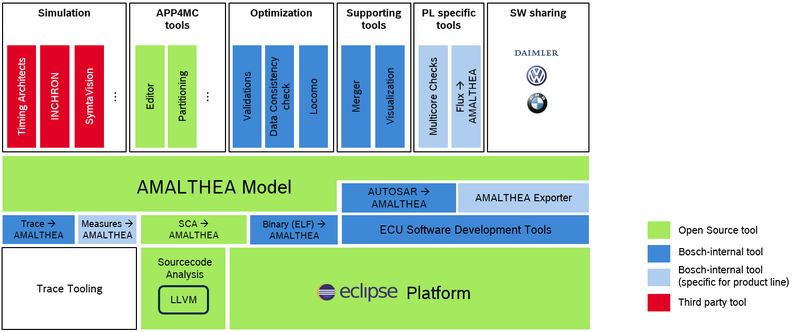AMALTHEA & AMALTHEA
4public
From individual approaches to a widely accepted open platform

The AMALTHEA and AMALTHEA4public ITEA projects are part of a 'string of pearls' in the automotive domain; successes that have pushed this domain into the next phase of its development.
Modelling the dynamic software architecture of embedded real-time systems
AUTOSAR, a result from the former ITEA project EAST-EEA, defined a methodology for component-based development of automotive software and a standardised software architecture for automotive electronic control units. However, AUTOSAR offered only limited support for detailed behaviour descriptions, which are indispensable for developing much more complex multi-core systems of high quality. Those require an increased exchange between tools. Especially multi-core optimisation relies on additional information like detailed timing behaviour.
The ITEA 2 AMALTHEA project (July 2011-April 2014) set about adapting existing development methods and tools and creating a common model that offers the required description capabilities on different abstraction levels. The follow-up project AMALTHEA4public (Sep 2014 - Aug 2017) was set up to foster the transfer into application and to create a sustainable open ("public") platform and a vibrant community of users and contributors. For this, the official Eclipse project APP4MC ("Application Platform Project for MultiCore") was created in 2015.
The project involved 25 partners from 6 countries, including some industrial and academic members from the UsiXML End User Club. This consortium facilitated a challenging design and development process to enable the production of realistic and complex industrial applications.
Platform for multi-core software and hardware modelling
One of the major achievements of the AMALTHEA consortium, consisting of 15 partners from Finland, Germany and Turkey, was a common meta-model for multi-core software and hardware modelling that enables integration of heterogeneous tools in a custom tool chain to gain easy and efficient access to the overall characteristics of a multi-core system. The AMALTHEA platform is distributed under the Eclipse open source licence (EPL) and allows efficient data exchange between different cooperating companies but also between different (new and/or existing) tools used by a single organisation.
The AMALTHEA model was taken to a next level by the AMALTHEA4public consortium, comprising 20 partners from Germany, Spain, Sweden and Turkey, by adding additional features like verification and test generation as well as traceability of requirements.


In 2015 the AMALTHEA4public framework was moved to the newly created open source project Eclipse APP4MC, an open tool platform for modelling, analysis and optimisation of embedded multi- and many-core software (www.eclipse.org/app4mc/). APP4MC was created by AMALTHEA4public project participants Robert Bosch GmbH, itemis AG, Timing Architects Embedded Systems GmbH, Dortmund University of Applied Sciences and Arts and Eclipse Foundation Europe GmbH. In 2016 a second Eclipse project Capra (www.eclipse.org/capra/) was created. It contains the traceability management tools mainly contributed by the Swedish AMALTHEA4publicpartners. Furthermore, community building is ongoing via the Eclipse Open Source network. This has led to a healthy community of currently 12 committers, 9 contributors and hundreds of users. A three-month release cycle has been established to keep the software and data model up to date. Users worldwide downloaded each release several hundred times.
Lubricating the links in the automotive supply chain
AMALTHEA4public partners AVL, BHTC and Bosch demonstrated the applicability of the project's results in industry in several projects incorporating different companies. The AMALTHEAdata model or platform is currently in use with some major automotive vendors coming from several countries in the world. For example, BMW, Daimler, Volkswagen and PSA use the format and the APP4MC platform in cooperation with their tool vendors and tier suppliers.
The Bosch internal tooling for embedded multi-core is based on the AMALTHEA model as a central component. Several tools are extracting information, e.g. from source code or event traces. Bosch uses the consolidated model as input for (commercial and in-house) tools and to exchange timing information with customers. Bosch intends to publish some tools as open source to further support the APP4MC platform. The source code analysis tool "SCA2AMALTHEA" was the first contribution of that kind in August 2017.
Dr. Michael Deubzer (Co-Founder and CEO of Timing-Architects Embedded Systems GmbH, now part of Vector Informatik) states: "AMALTHEA is the ideal format solution for many of our customers working with software modelling for real-time analysis. The Eclipse Framework APP4MC offers AMALTHEA users an easy start and supports the first steps on the path of introducing model-based timing analysis with well-developed and maintained basic functions, such as Import/Export APIs. The easy connection of market-proven tools, the possibility to extend it with specially developed plugins, as well as the possibility to connect in-house or unsupported 3rd party tools via the open interface by yourself, make APP4MC a practical basic framework for future-oriented software development. Some of our well-known automotive OEM and TIER1 customers have now set AMALTHEA as the internal Group standard for modelling the dynamic software architecture of ECUs."
Furthermore, in the official proceedings of the ERTS 2016 (http://web1.see.asso.fr/erts2016/uploads/pdf/erts_2016_Proceedings.pdf), Volkswagen/Audi and Continental published the article "Shared SW development in multi-core automotive context" in which AMALTHEA was promoted as a collaboration model between OEM and TIER-1. According to the proceedings, compared to ASAM-MDX and AUTOSAR, the AMALTHEA format (v1.1.1) adds features and more support for the dynamic description of the software. It extends the architecture and timing requirements and gives possibilities to describe more technical design properties, for example of the target platform with its hardware or the operating system. For use cases like software simulation and partitioning of the software in multi-core context, this is advisable. This format is suitable for the exchange of complete system description typically generated from the TIER-1 side, which is responsible for the integration.
Real-world automotive benchmarks for free
Due to its open nature, universities are able to use APP4MC successfully in teaching. For example, FH Dortmund organised several APP4MC-focused summer schools. In addition, several Master and PhD theses were conducted in the context of APP4MC at FH Dortmund, Fraunhofer IEM, University of Gothenburg, and Paderborn University. Furthermore, the project also provided the opportunity for about 60 students to use their expertise in the industry. Some 8 students involved in the project were directly hired by industry companies to ramp up and enhance their know-how in multi- and many- core performance and work in close cooperation with the Eclipse APP4MC developer team.

The introduction of multi-core systems strongly increased the problem space for timing analysis. In the last decade there has been a divergence between academic research and industrial practice because of the absence of realistic benchmarks, mainly due to intellectual property (IP) concerns. Meanwhile, with the help of the AMALTHEA format, real-world benchmarks are available and the exchange between research and industry is alive and ongoing. In 2016 and 2017 Bosch provided the problem description for the "Formal Methods for Timing Verification" (FMTV) Challenges as AMALTHEA models. The results were presented at international workshops at the ECRTS conferences (waters2017.inria.fr/challenge/).
A fundamental cooperation between academic and industry has been built to master the imminent performance challenges within the new EE architectures. Thereby, the AMALTHEA and AMALTHEA4public projects contribute to the training of future specialist and managers.
AMALTHEA and its successor projects have shown how an idea for a narrow application (timing analysis of multi-core automotive and telecom systems at some companies) can become an extensive application in many core systems for the most diverse applications in a big number of companies. And still a third dimension is the development and use by a project consortium towards publication as an open source project and thus further development and use by every possible company.
More information
Download AMALTHEA and AMALTHEA4public Success stor…Related projects
AMALTHEAAMALTHEA4public
Organisations
AVL Turkey (Türkiye)BHTC (Germany)
Dortmund University of Applied Sciences and Arts (…
Eclipse Foundation Europe GmbH (Germany)
Fraunhofer (Germany)
Itemis (Germany)
Robert Bosch GmbH (Germany)
Timing Architects (Germany)
University of Gothenburg (Sweden)
University of Paderborn (Germany)

